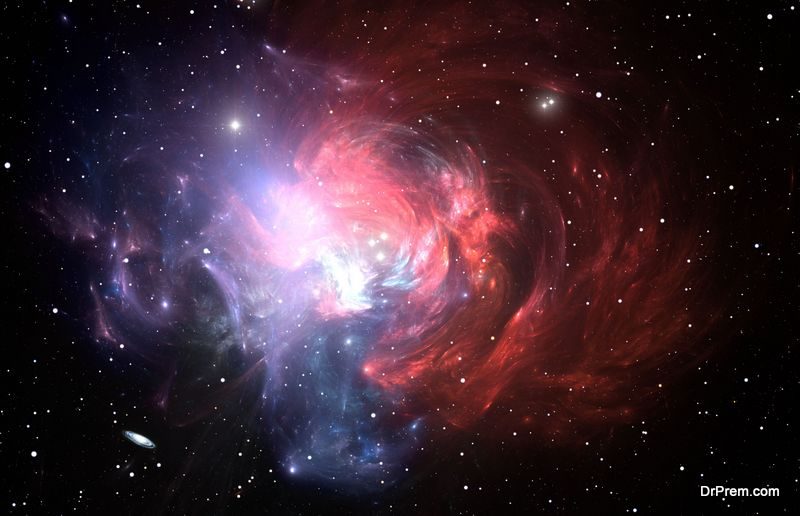If you look at the sky, it will be the same as yesterday. Reality is different. At times, there are explosions that rock the space, something like a Supernova. The explosion of a star that has reached the end of its life is known as Supernova.
What is supernova?
 When a massive star runs out of fuel burning its core, the core collapses inwards and explodes to rebound outwards. Such explosion outshines the entire galaxy and can create enough light that our Sun has generated in its entire life. After the explosion, the outer layers are blasted away leaving a dense neutron star with a size of a small city but mass more than our Sun.
When a massive star runs out of fuel burning its core, the core collapses inwards and explodes to rebound outwards. Such explosion outshines the entire galaxy and can create enough light that our Sun has generated in its entire life. After the explosion, the outer layers are blasted away leaving a dense neutron star with a size of a small city but mass more than our Sun.
What’s new about this supernova?
Supernovae are common, but scientists have discovered a new type rapidly fading explosion possible to create binary neutron star. The research, led by Caltech team, including Anthony Piro, Khalay De, a graduate student in the laboratory of Mansi Kasliwal who is an assistant professor of astronomy. Mansi is also a principal investigator at GROWTH (Global Relay of Observatories Watching Transients Happen) project. The latest scientific discovery referred as iPTF 14gqr (SN 2014ft) was discovered first in October 2014 in a spiral galaxy 920 million light years away from us.
Neutron Stars
 Collapsed, dead and burnt out core of dead stars are known as Neutron stars. A typical neutron star has one and a half million times more than the Earth, but they are commonly about 20 kilometers (12 miles).
Collapsed, dead and burnt out core of dead stars are known as Neutron stars. A typical neutron star has one and a half million times more than the Earth, but they are commonly about 20 kilometers (12 miles).
Apart from the event described above, there is another mysterious flash named as AT2018COW or the Cow. Let us have a look at the same.
Chain of events
First detected on 16th June 2018 above Hawaii, it was reported by Stephen Smartt through The Astrologer’s Telegram, an online application to circulate new Astronomical information. The application used a three letter naming system to name the new supernova as AT2018COW or “The Cow” in short. As per Smartt, there was nothing a few days back. At 11 pm on Sunday night, he observed the light emission and informed everyone. Everyone left whatever they were working on and immediately started following the cow.
By 22nd June 2018, every scientist was interested to know more about the new supernova and more than 24 telescopes were monitoring the event. The discovery team discussed the same in an article published in the famous science magazine – New Scientist. As per the team, they saw an immense light flashing from another galaxy that should be 200 million light years away. The flash coming to us was10 to 100 times brighter than a normal supernova. Generally, it takes, several weeks for a star to reach such luminosity, but the cow was flashing a very large amount of light within three days. This is the main reason, it immediately garnered the attention of scientists across the globe.
Initially, Stephen Smartt thought that the new supernova is bursting in our own galaxy because of its brightness. But, when they conducted spectroscopic analyses (study wavelength of visible light) of the same, they came to know that the burning star is associated with CGCG 137-068, galaxy in a different constellation referred as Hercules.
On 25th October, two teams of researchers led by Raffaella Margutti submitted the paper on the arXiv preprint server. Margutti, an astrophysicist at Northwestern University (Illinois) states that this latest scientific discovery is a dream come true for scientists studying stellar explosions.
The two independent groups who submitted the paper explains: the central engine must be troubling the star from inside, from a couple of months and the energy must have come through a new black hole accumulating matter or from the energetic and the uncontrolled rotation of the neutron star. Smartt has something similar to say, as per him, it is composed of 9,000 degree Celsius (16,000 degrees Fahrenheit) high energy particles moving outwards with a speed of 20,000 kilometers (12,000 miles) per second. The electromagnetic spectrum of the new supernova is super smooth as compared to other supernovae that generally have distinguishable absorption lines.
The findings
 For a star to reach the supernova level, it has been at least several times bigger masses, then about the Sun, The phenomena observed by Mansi, ejected only 1/5th mass of the Sun. So, where is the missing mass? It must be stolen by a neutron star, black hole or a white dwarf. The team also founded a helium-filled envelope around the new supernova that stopped the ejection of its outer mass. Probably, it happened in the formation of binary neutron star . These two stars quite close to each other will eventually result in a collision producing electromagnetic and gravitational waves. When it will collide, nobody knows because this is one of the first incidents that is recorded. Maybe none of the scientists were able to notice any such explosion because it happens very fast and remains for a very short time period.
For a star to reach the supernova level, it has been at least several times bigger masses, then about the Sun, The phenomena observed by Mansi, ejected only 1/5th mass of the Sun. So, where is the missing mass? It must be stolen by a neutron star, black hole or a white dwarf. The team also founded a helium-filled envelope around the new supernova that stopped the ejection of its outer mass. Probably, it happened in the formation of binary neutron star . These two stars quite close to each other will eventually result in a collision producing electromagnetic and gravitational waves. When it will collide, nobody knows because this is one of the first incidents that is recorded. Maybe none of the scientists were able to notice any such explosion because it happens very fast and remains for a very short time period.
Similar Incidents
Not exact but similar incident was first recorded in 2017 by Piro, UC Santa Cruz astronomers and a team of Carnegie. They think that these events are the reason behind the existence of heavy elements in our universe such as titanium and gold.
IPTF 14gqr is a rare and short-lived event. The researchers observed the same initials and arrived at the fact that it will produce two massive stars.
The new supernova was first observed at the Intermediate Palomar Transient Factory (IPTF), which is a survey to record events like supernovae. As the earth moved and Palomar telescope went out of range, scientists collaborated to observe iPTF 14gqr and stated that the new supernova may result in a neutron star binary system.
The successor of iPTF at Palomar Observatory, The Zwicky Transient Facility is observing the sky in a broad manner to record more such explosions that make only one percent of all observed events. In collaboration with GROWTH, such incidents are recorded so that scientists can understand how a neutron binary system is formed from a massive star.
What the scientists have to say:
 Mansi Kasliwal, California Institute of Technology (Pasadena) states, such incidents tells as the exact process of how a black hole is formed.
Mansi Kasliwal, California Institute of Technology (Pasadena) states, such incidents tells as the exact process of how a black hole is formed.
Iair Arcavi, University of California (Santa Barbara) adds, the strange emission of light something that we have not seen before.



